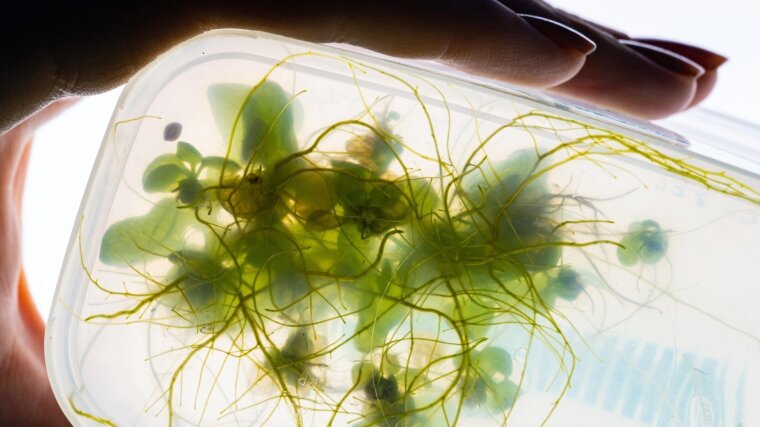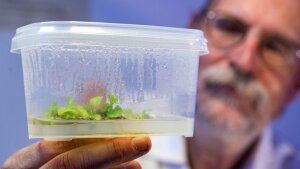
They are among the organisms with the most extensive genomes – the genetic material of a fern plant may have up to 720 chromosome pairs. The extravagant size and complexity have so far made it hard for researchers to clarify fundamental aspects of fern biology and the evolution of land plants through genome-based research. However, an international team has now succeeded in fully decoding one of the first fern genomes, with some surprising results.
By Ute Schönfelder
Sequencing the genome of Ceratopteris richardii was a truly mammoth task. It took researchers from a total of 28 institutions around the world more than eight years to decode the fern's huge genome, which has 7.46 gigabase pairs (billion base pairs) – more than twice as many as humans.
The fern Ceratopteris richardii belongs to the monilophytes, the closest living relatives of all seed-bearing plants, which include not only ferns but also horsetails in particular.
»The small plant is easy to cultivate and grows very quickly, so it can be used to study the entire life cycle of a fern plant,« says Prof. Günter Theißen of the University of Jena. That makes this fern the ideal model organism for research, says Theißen, explaining the importance of the plant, which is fairly inconspicuous to laypeople but known as "water fern" by nearly every aquarium enthusiast. Genetics professor Theißen is part of the team that has now published the Ceratopteris genome.
Prof. Günter Theißen is one of the authors of the publication in “Nature Plants”. The paper describes how an international research team has decoded and analysed the complete sequence of the genome of Ceratopteris richardii (seedling in the box).
Image: Jens Meyer (University of Jena)Repetitive sequences make up 85 per cent of fern DNA
The analysis of the genome now provides the researchers with the first clues as to why ferns contain so much DNA. Since the 1960s, it had been assumed that this was due to multiple duplication of the genome, in which an extra set of chromosomes is accidentally passed on to the offspring. Such duplications of the entire genome are known from many plants, and even animals, but it has now become apparent that they are not solely responsible for the size of the Ceratopteris genome. If Ceratopteris had accumulated its DNA through repeated genome duplications, large parts of its genetic material should have shown characteristic similarities, but this is not the case.
Instead, the researchers found a hotchpotch of repeated sequences and millions of short gene snippets that together made up 85 per cent of the fern's DNA. Therefore, instead of multiple genome copies, Ceratopteris mainly contains genetic »junk« that has accumulated over millions of years.
This »junk« is above all the result of the activity of transposons and retrotransposons, known as »jumping genes«, which occur in all higher organisms, but apparently feel particularly at home in fern genomes.
Insights into the evolutionary history of flowers, fruits and seeds
Günter Theißen's team in Jena is not so interested in the many leftovers of transposons and retrotransposons activity in the genome, but instead it has identified and analysed the fern's MADS-box genes as part of the study. Members of this gene family control important developmental processes in flowering plants, especially flower and fruit development.
»To find out how flowers and fruits developed in the course of evolution, we have been studying the evolutionary history of these genes in my research group for a long time,« says Theißen. He and his colleagues were also one of the first groups ever to isolate some MADS-box genes from the fern Ceratopteris richardii, some 25 years ago. However, it is only with the analysis of the complete sequence of the fern genome that it has been possible for the first time to obtain a complete overview of all MADS-box genes present in the fern.
»The results show us that 25 years ago, we had already gained quite a representative overview, but not a complete collection of the genes we were interested in,« adds Theißen. It has now been confirmed that the specific subfamilies of MADS-box genes that control flower development in flowering plants arose as early as 300-400 million years ago in the evolutionary lineage that led to today's seed-bearing plants, after the lineage that led to the ferns that exist today had already split off.
The fern genome sequence that is now available also provides the basis for completely new research questions for the working group led by Theißen. »We want to test the hypothesis that changes in specific MADS-box genes played a role in the formation of the seed – one of the most important innovations of land plants and an essential basis of human nutrition.« The functional studies using Ceratopteris richardii that are required for this are technically challenging, but they have become much easier with the genome sequence now published.
Original publication:
Dynamic genome evolution in a model tern. Nat. Plants (2022). https://doi.org/10.1038/s41477-022-01226-7 External link
